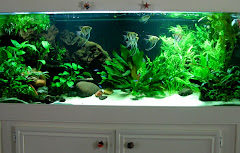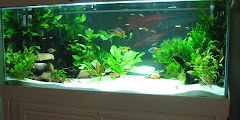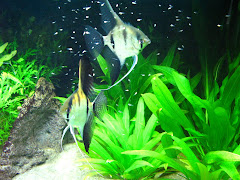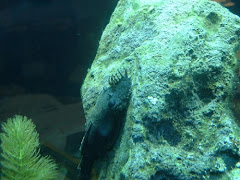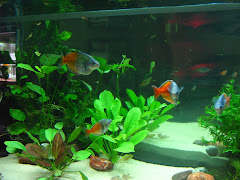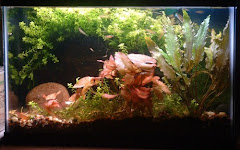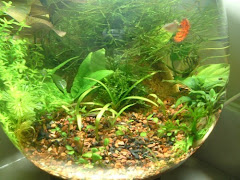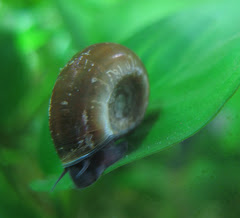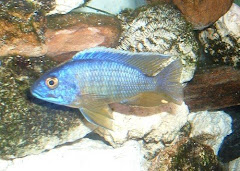 Some time has passed and things are settling in rather well. The CO2 is running, the plants have filled in (almost too much - I thought this was a 150-gallon tank? Looks like a 55 to me....).
Some time has passed and things are settling in rather well. The CO2 is running, the plants have filled in (almost too much - I thought this was a 150-gallon tank? Looks like a 55 to me....).
I believe the Play Sand substrate has introduced a quantity of organic compounds to the water column, causing a general drop in pH (prior to CO2 injection). This does not worry me too much, and over time will resolve. I am not going to fret too much about something that is not causing any actual problems. I'm still dropping the pH down to 6.4 with CO2, regardless of where it was to begin with. I purchased, quarantined and added a pair of Ancistrus sp., juveniles, about 2.5". They are doing a good job of keeping the glass free from the slight algae accumulation, and when I keep an eye on NO3 (adding it up to 10 ppm, that is) then I don't have much of a hair algae problem. The plants are growing like gangbusters - I have to hack them back out of the way. There are a million Endler's/guppy babies, not quite so many adults of same, the cory cats and the cardinals, as before. Things have been stable in there for quite a while now according to my log, especially once I started dosing nutrients. It still has what I would consider moderate lighting, with 4x65w CF in the hood. I added a 108w T5HO fixture, but that did not seem to help anything but the algae, so I removed it. I don't think I need the extra lighting.
One day about a week ago I was posting on a forum regarding our favorite LFS, Azalea Aquariums. There are several locals on this forum and we had been discusing the merits (and demerits, lol) of the shops in our area. One fellow posted that he went over to Azalea to look at the wild caught Peruvian P. altums he was waiting for, and when he got there the owner explained that they were not altums but P. scalare, or the wild version of your basic angelfish. The ones you see in most every shop are P. scalare, though they have been genetically engineered to produce the marble, koi, veil, ghost, black, gold, etc. specimens that you see. I had planned on angels in the future for the 150, and I wanted wild types - I don't particularly care for the modern morphs. I went straight over there and purchased 3 - they were expensive and larger than I would have preferred - so 3 was all I was able to get at that time.
I put them in quarantine in the 40g tank, after spending at least an hour catching every single one of the "mystery fry" that I was growing out in there. I have become quite attached to these little guys, and I knew they'd be eaten if I left them in with the angels, so I put them in the 10g Endler's growout tank. They blend right in - I have to really look to find them since they are the same size and general shape as the baby Endler's.
The three angels had a rough start. These are wild fish and completely unaccustomed to people and glass boxes to live in. They hid for 36 hours. In my research I had upped the temp in the tank to 82, and chewed my nails over them. I found an angelfish forum and posted about them, desperate for a magic trick to get them to swim around and eat. I could not even see them properly, because if I put my head beside the tank to look in the cave where they hid, they'd spook and risk injuring themselves, so I would not even look at them.
I got some great advice, and it was suggested to raise the temp in the tank to 85, just for an interval as they acclimated to life with Liz. I would always need to keep the temp higher than I typically do (~76-78) but it would not have to be 85F forever. There were also other fish in the tank that showed signs of ich, and the owner admitted that they were in rough shape for the 10 weeks he had had them, but had recovered and were doing great now. I thought I'd treat with salt and heat, since the heat was already up anyway.

After a fashion they finally ventured out, much to my relief. I was able to get some pictures of them, and when I posted them to demonstrate that they had finally come out, it was suggested that these fish were not P. scalare, but actually P. leopoldi, due to their fainter markings and prominent spot at the base of the dorsal fin. I was thinking they had just faded coloration due to stress, but it was possible, based on the pics I saw on the web.

A forum member indicated that she had an acquaintance with Heiko Bleher, who is a renown explorer and has discovered many species of freshwater aquarium fish. He is known specifically for particular knowledge in discus and angelfish strains. I could not imagine that such a fellow would take the time to look at pics of my fish, but I told her I'd be delighted if she contacted him!
Lo and behold, she did, and he replied to me regarding my fish. He assures me, without any doubt, these fish are P. leopoldi, and not from Peru at all, but from Bolivia. Here is an excerpt from his message:
They are definitely P. leopoldi - no question whatsoever, and you have some beauties there. Also you tank is very beautiful. I am sure your shop does not know where they come from, but they are from the Rio negro system, not from Peru. His shipper (importer/wholesaler) received them surely from Brazil.
You know P. leopoldi are only found in the Rio Negro and Solimões regions. They never grow very large (not as P. sclare or P. altum), have always their head/nose slightly downwards pointed (all populations of P. leopoldi have) and although their colour pattern may vary somewhat (depending of the collecting spot, I think yours comes from an left affluent of the Rio Negro near Barcelos, I colelcted same colour pattern their), but all will also have always a black spot on the base of the dorsal fin."
This is great information to have, so I went back to the LFS and the owner was glad to learn about the correct ID, and I got two more to join the group.

